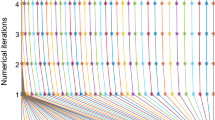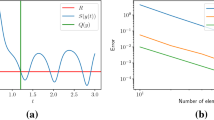Abstract
In this work, we consider a system of Volterra integro-differential equations with initial conditions. The derivative term in equations is multiplied with distinct small positive parameters giving rise to overlapping layers. We propose a numerical scheme that avoids the extra condition on the problem’s data required by the scheme of Liang et al. (Comput Appl Math 39:255, 2020). We derive a priori and a posteriori error bounds for the proposed scheme and further rectify the shortcomings of a posteriori error estimation in Liang et al. (Comput Appl Math 39:255, 2020). Numerical results are presented in the form of graphs and tables that validate the proposed theory.


Similar content being viewed by others
Data availability
Data sharing not applicable to this article as no datasets were generated or analyzed during the current study.
References
Aakansha, Singh J, Kumar S (2021) Additive schemes based domain decomposition algorithm for solving singularly perturbed parabolic reaction-diffusion systems. Comput Appl Math 40:82
Amiraliyev G, Şevgin S (2006) Uniform difference method for singularly perturbed Volterra integro-differential equations. Appl Math Comput 179(2):731–741
Cakir M, Güneş B (2022) A new difference method for the singularly perturbed Volterra-Fredholm integro-differential equations on a Shishkin mesh. Hacettepe J Math Stat 51(3):787–799
Cakir M, Gunes B (2022) A fitted operator finite difference approximation for singularly perturbed Volterra-Fredholm integro-differential equations. Mathematics 10(19):3560
Das P (2015) Comparison of a priori and a posteriori meshes for singularly perturbed nonlinear parameterized problems. J Comput Appl Math 290:16–25
De Boor C (1974) Good approximation by splines with variable knots ii. Conference on the numerical solution of differential equations. Springer, Berlin, pp 12–20
Gupta V, Sahoo SK, Dubey RK (2021) Robust higher order finite difference scheme for singularly perturbed turning point problem with two outflow boundary layers. Comput Appl Math 40:179
Huang J, Cen Z, Xu A, Liu L-B (2020) A posteriori error estimation for a singularly perturbed Volterra integro-differential equation. Numer Algor 83(2):549–563
Iragi BC, Munyakazi JB (2020) A uniformly convergent numerical method for a singularly perturbed Volterra integro-differential equation. Int J Comput Math 97(4):759–771
Iragi BC, Munyakazi JB (2020) A uniformly convergent numerical method for a singularly perturbed Volterra integro-differential equation. Int J Comput Math 97(4):759–771
Kadalbajoo MK, Gupta V (2010) A brief survey on numerical methods for solving singularly perturbed problems. Appl Math Comput 217(8):3641–3716
Kudu M, Amirali I, Amiraliyev GM (2016) A finite-difference method for a singularly perturbed delay integro-differential equation. J Comput Appl Math 308:379–390
Kumar S, Kumar S, Sumit (2022) A posteriori error estimation for quasilinear singularly perturbed problems with integral boundary condition. Numer Algor 89:791–809
Sumit, Kumar S, Kumar S (2022) A high order convergent adaptive numerical method for singularly perturbed nonlinear systems. Comput Appl Math 41:83
Kumar S, Sumit, Ramos H (2021) Parameter-uniform approximation on equidistributed meshes for singularly perturbed parabolic reaction-diffusion problems with robin boundary conditions. Appl Math Comput 392:125677
Kumar S, Sumit, Vigo-Aguiar J (2022) A parameter-uniform grid equidistribution method for singularly perturbed degenerate parabolic convection-diffusion problems. J Comput Appl Math 404:113273
Kumar S, Sumit, Vigo-Aguiar (2022) A high order convergent numerical method for singularly perturbed time dependent problems using mesh equidistribution. Math Comput Simul 199:287–306
Li Y, Xu R, Jiazhe J (2019) Global dynamics for a class of infection-age model with nonlinear incidence. Nonlinear Anal Model Control 24(1):47–72
Liang Y, Liu L-B, Cen Z (2020) A posteriori error estimation in maximum norm for a system of singularly perturbed Volterra integro-differential equations. Comput Appl Math 39(4):1–17
Linß T (2009) Layer-adapted meshes for reaction-convection-diffusion problems. Springer, Berlin
Liu L-B, Liao Y, Long G (2023) A novel parameter-uniform numerical method for a singularly perturbed Volterra integro-differential equation. Comput Appl Math 42(1):12
Makroglou A (2003) Integral equations and actuarial risk management: some models and numerics. Math Model Anal 8(2):143–154
Mbroh NA, Munyakazi JB (2019) A fitted operator finite difference method of lines for singularly perturbed parabolic convection-diffusion problems. Math Comput Simul 165:156–171
Miller JJ, O’riordan E, Shishkin GI (1996) Fitted numerical methods for singular perturbation problems: error estimates in the maximum norm for linear problems in one and two dimensions. World scientific, Singapore
Munyakazi JB (2015) A uniformly convergent nonstandard finite difference scheme for a system of convection-diffusion equations. Comput Appl Math 34:1153–1165
Panda A, Mohapatra J, Amirali I (2021) A second-order post-processing technique for singularly perturbed Volterra integro-differential equations. Mediterr J Math 18:1–25
Ramos JI (2008) Exponential techniques and implicit Runge Kutta methods for singularly perturbed Volterra integro differential equations, Neural. Parallel Sci Comput 16(3):387
Sahoo SK, Gupta V (2021) Second-order parameter-uniform finite difference scheme for singularly perturbed parabolic problem with a boundary turning point. J Differ Equ Appl 27(2):223–240
Sahoo SK, Gupta V (2022) Higher order robust numerical computation for singularly perturbed problem involving discontinuous convective and source term. Math Methods Appl Sci 45(8):4876–4898
Scudo FM (1971) Vito Volterra and theoretical ecology. Theor Popul Biol 2(1):1–23
Sumit, Kumar S, Vigo-Aguiar J (2021) Analysis of a nonlinear singularly perturbed Volterra integro-differential equation. J Comput Appl Math 404:113410
Tao X, Zhang Y (2019) The coupled method for singularly perturbed Volterra integro-differential equations. Adv Differ Equ 2019(1):1–16
TeBeest KG (1997) Classroom note: numerical and analytical solutions of Volterra’s population model. SIAM Rev 39(3):484–493
Yapman Ö, Amiraliyev GM (2020) A novel second-order fitted computational method for a singularly perturbed Volterra integro-differential equation. Int J Comput Math 97(6):1293–1302
Yapman Ö, Amiraliyev GM (2021) Convergence analysis of the homogeneous second order difference method for a singularly perturbed Volterra delay-integro-differential equation. Chaos Soliton Fract 150:111100
Acknowledgements
The authors would like to express great appreciation to anonymous reviewers for their valuable comments and suggestions, which have helped to improve the quality and presentation of this paper.
Author information
Authors and Affiliations
Corresponding author
Ethics declarations
Conflict of interest
The authors declare that they have no conflict of interest.
Additional information
Communicated by Hui Liang.
Publisher's Note
Springer Nature remains neutral with regard to jurisdictional claims in published maps and institutional affiliations.
Appendix A. A posteriori error analysis for the discrete scheme of Liang et al. (2020)
Appendix A. A posteriori error analysis for the discrete scheme of Liang et al. (2020)
The main aim of this appendix is to present the correct a posteriori error analysis for the discrete scheme of Liang et al. (2020). For this purpose, we first mention the discrete scheme considered in (Liang et al. 2020, Sect. 3) for the continuous problem (1.1)–(1.2):

One could obtain the first identity in the proof of (Liang et al. 2020, Theorem 1) only by using \({\mathcal {E}}D^{-}{\textbf{V}}_{i}+A_{i}{\textbf{V}}_{i}+\displaystyle \sum _{k=1}^{i}\int _{t_{k-1}}^{t_{k}}B(t_{i}, s){\textbf{V}}_{k}\,ds={\textbf{f}}_{i},\) which obviously does not hold true. The following lemma provides the correct a posteriori error estimation for the discrete scheme (A.1)–(A.2).
Theorem Appendix A.1
Let \({\textbf{v}}=(v_{1}, v_{2}(t))^{T}\) be the solution of the continuous problem (1.1)–(1.2), \(\{{\textbf{V}}_{i}\}_{i=0}^{N}\) be the solution of the discrete problem (A.1)–(A.2) and \(\mathbf {\widetilde{V}}\) be its piecewise linear interpolation vector as defined in (4.1). Then,
Proof
For \(\forall t\in (t_{i-1}, t_{i})\), we have
where we have used (A.1). Now, we evaluate each terms of (A.4) separately. By Taylor expansions of B(t, s) about \((t_{i}, t_{k})\) for some \((\rho , \varsigma )\) in between (t, s) and \((t_{i}, t_{k})\), it holds
Next, we use the arguments in Theorem 4.1 to obtain
The rest of the terms can be estimated similar to Theorem 4.1. Thus, we obtain
Hence, using (2.2), we finally get the desired result (A.3). \(\square \)
Rights and permissions
Springer Nature or its licensor (e.g. a society or other partner) holds exclusive rights to this article under a publishing agreement with the author(s) or other rightsholder(s); author self-archiving of the accepted manuscript version of this article is solely governed by the terms of such publishing agreement and applicable law.
About this article
Cite this article
Jaiswal, A., Kumar, S. & Kumar, S. A priori and a posteriori error analysis for a system of singularly perturbed Volterra integro-differential equations. Comp. Appl. Math. 42, 278 (2023). https://doi.org/10.1007/s40314-023-02406-7
Received:
Revised:
Accepted:
Published:
DOI: https://doi.org/10.1007/s40314-023-02406-7
Keywords
- A posteriori mesh
- Mesh equidistribution
- Monitor function
- Volterra integro-differential equation
- Layer-adapted mesh




